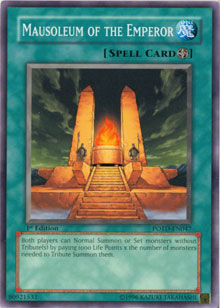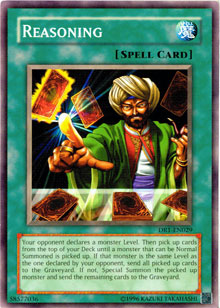As much as I enjoy control decks and stasis decks in any trading card game, I have to admit that I enjoy a combo deck in Yu-Gi-Oh! TCG once in a while. Specifically, I love decks focused on using Hino-Kagu-Tsuchi or Yamata Dragon. I can’t help liking these Spirit monsters. They’re big, they’re fiery, and they tend to utterly annihilate opponents they come into contact with.
Decks based on inflicting life point damage with one of those two Spirits might as well be considered a combo deck. After all, it takes a lot of work to set up the tributes required to summon a Hino-Kagu-Tsuchi, and then—when it’s on the field for its one turn—inflict damage to your opponent with it! The reward is pretty sweet, though, as you force your opponent to discard his or her hand. This can be game winning if you follow up properly, despite the fact that you are left with almost no field after dedicating your game plan to just getting in one direct attack. The same concerns apply to Yamata Dragon. While the two Spirits are very powerful, they require a lot of field presence to summon.
 Well, to be honest, they only require monsters on the field when you’re not being a sneaky combo player. Mausoleum of the Emperor is one of the most combo-happy cards to be released in Power of the Duelist. It’s also begging to be used with the two-tribute Spirit monsters in Yu-Gi-Oh! TCG.
Well, to be honest, they only require monsters on the field when you’re not being a sneaky combo player. Mausoleum of the Emperor is one of the most combo-happy cards to be released in Power of the Duelist. It’s also begging to be used with the two-tribute Spirit monsters in Yu-Gi-Oh! TCG.
Before the release of Mausoleum of the Emperor, larger tribute monsters such as Hino-Kagu-Tsuchi could only be summoned the hard way (i.e. having two monsters on your field to tribute away). In some cases you could get around this by simply tributing a Flame Ruler, but you were usually still bound to fulfilling those two painful tributes. Mausoleum of the Emperor circumvents this. Instead, by paying 1000 life points for each tribute required, you can normal summon or set it without having to build up a field! So instead of tributing two Nimble Momonga cards or one Flame Ruler for Hino-Kagu-Tsuchi, you can simply drop Mausoleum of the Emperor on turn 1, pay 2000 life points, and then blast your opponent in a fury of damage and discarded cards. Yes, you can do all of this on turn 1 (assuming you didn’t go first). The advantage of not needing monsters out to summon Hino-Kagu-Tsuchi is that you can blast the opponent with only a Giant Trunade (or some other spell or trap removal), a Mausoleum of the Emperor, and the monster your deck is based around! With only those cards, you can actually force your opponent into top-decking as he or she enters the second turn.
This same logic can also be applied to Yamata Dragon. The difference is that while you are trying to hit your opponent with Hino-Kagu-Tsuchi as fast as possible, you are just looking for an opportunity to draw cards with Yamata Dragon. Normally, you would have to risk the chance that your opponent might counter your Yamata Dragon attack, simply because it requires two tributes for you to summon it to the field. This isn’t the case with Mausoleum of the Emperor. Your opponent can go on the offensive while you only have a couple of cards in your hand, and you could still get an attack in with your gigantic Fire Dragon. With Mausoleum of the Emperor, you can take your time to find the right opportunity to attack. When you do, set all the cards that you can put in your spell and trap zone, play your Mausoleum of the Emperor, summon Yamata Dragon at the cost of 2000 life points, and draw a ton of cards the moment you make contact with your opponent’s life points! Trust me when I say it’s a bargain to draw five cards at the expense of 2000 life points.
 Mausoleum of the Emperor isn’t exclusive to those two Spirit monsters, however. This field spell can be a great safety net for decks based around big monsters and the key spells Monster Gate and Reasoning. Normally, these decks don’t want to actually draw into their high-level monsters. They would prefer that those monsters remain in the deck. However, there are times where you will end up drawing a couple of them, and this is where Mausoleum of the Emperor’s use is revealed. By playing it, you are free to summon those high-level monsters as easily as you could with a timely Reasoning!
Mausoleum of the Emperor isn’t exclusive to those two Spirit monsters, however. This field spell can be a great safety net for decks based around big monsters and the key spells Monster Gate and Reasoning. Normally, these decks don’t want to actually draw into their high-level monsters. They would prefer that those monsters remain in the deck. However, there are times where you will end up drawing a couple of them, and this is where Mausoleum of the Emperor’s use is revealed. By playing it, you are free to summon those high-level monsters as easily as you could with a timely Reasoning!
Of course, when I say “high-level monster,” I’m almost always thinking about Dark Magician of Chaos. I’m thinking about paying 2000 life points to normal summon a 2800 ATK monster that removes monsters it destroyed from play, and when I summon this monster I get a spell card back from my graveyard. It’s not as though Dark Magician of Chaos actually needs another reason to be good.
More importantly, Mausoleum of the Emperor isn’t limited to a specific combo. Its effect allows you to play some of your more conditional cards more effectively. For example, decks based on Hino-Kagu-Tsuchi may already run Cyber Dragon, since it is easy to special summon and can also act as a decent attacker. Mausoleum of the Emperor gives you a chance to summon it almost effortlessly in case your opponent has dismantled your combo. This is similar to the safety net that Mausoleum of the Emperor provides to the various Reasoning decks that may end up drawing more big monsters than expected.
While Mausoleum of the Emperor doesn’t do much on its own, the benefit it provides for certain specific decks gives it quite a bit of power . . . if you can draw it. Fortunately, it’s a field spell, and field spells were blessed with Terraforming. Many players have seen Terraforming played at a premiere event or two as the search card for a Gravekeeper-deck’s key field spell, Necrovalley. Mausoleum of the Emperor is conveniently a field spell, so you can run copies of Terraforming along with the key field spell in order to get it into your hand more easily!
Mausoleum of the Emperor has suffered the same lack of attention as the decks I have mentioned today. It was simply overshadowed by larger events that took place around its release, such as the new Advanced format. It also was overlooked in Power of the Duelist since it was in the same set as the popular Chimeratech Overdragon. Yet Mausoleum of the Emperor completely transforms and expands upon some very powerful decks that lacked the consistency to do continuously well in tournaments. Perhaps you can make Hino-Kagu-Tsuchi a threatening sight at your local regional events.
If you have any question or comments regarding this or any previous articles of mine, feel free to e-mail me at Mrosenberg@metagame.com.